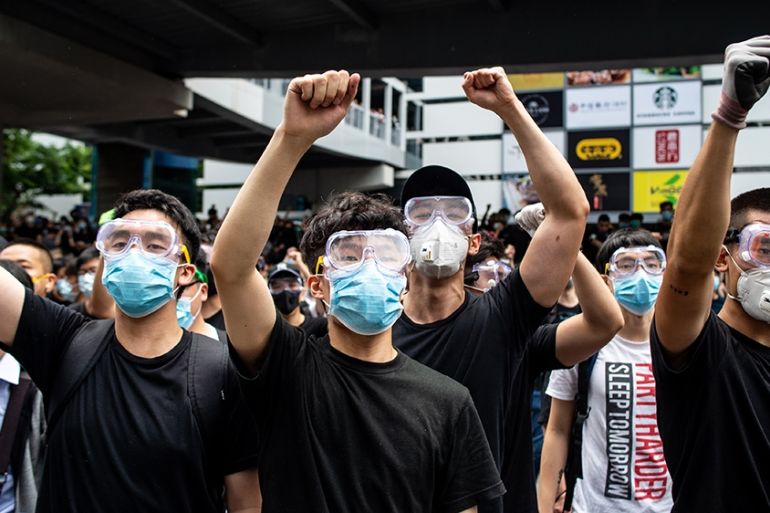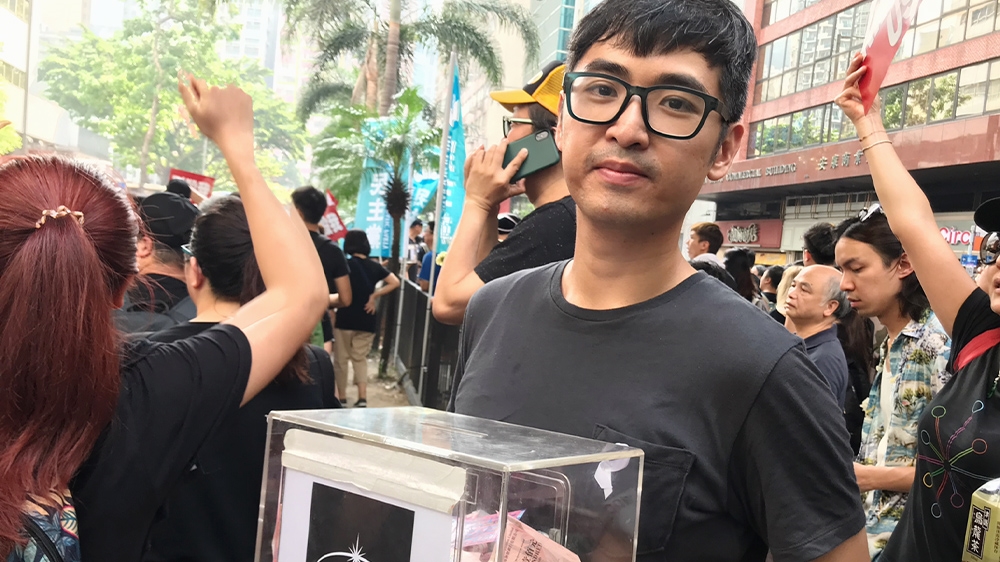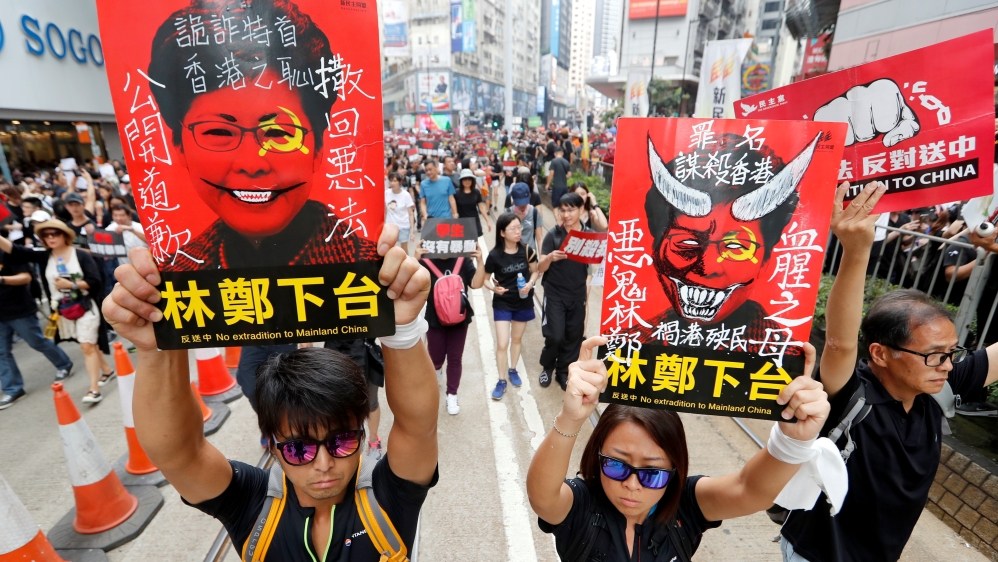‘Leaderless’: Inside the masked face of Hong Kong’s protests
Hong Kong’s anti-extradition bill protesters use social media to organise and seem more willing to risk confrontation.

Hong Kong, China – Millions of people took to the streets of Hong Kong over the past 10 days, stunning the authorities of the semi-autonomous Chinese territory and forcing the city’s pro-China leadership to shelve a proposed extradition bill.
Unlike the 2014 Umbrella Movement, the protesters this time around appeared more willing to take direct action and risk retaliation by the police.
Keep reading
list of 4 itemsHong Kong’s new security law comes into force amid human rights concerns
Hong Kong passes tough new national security law
What is Article 23, Hong Kong’s new draconian national security law?
On June 9, an estimated one million people marched in opposition to the controversial bill that would allow suspects to be extradited to mainland China for trial, sending a powerful message to Chief Executive Carrie Lam.
Three days later, tens of thousands were once again on the streets, surrounding the government complex where the bill was due to be debated. Some of the protesters, wearing masks and goggles and carrying umbrellas for protection, later attempted to storm the building, triggering retaliation by the police.
By Saturday, Lam had bowed to public pressure and said she would postpone the bill.
But the protersters wanted it withdrawn completely and Lam to resign.
The next day, an estimated 2 million Hong Kongers crowded the streets – the third big rally within a week. This time the police were more low-key.

Isaac Cheng, vice chairperson of pro-democracy group Demosisto described Hong Kong’s new movement as one fuelled by “independent protesters” who were not linked to any organisation.
While his own group believed in non-violent resistance, Cheng was careful not to criticise some of the more radical tactics used by some of the demonstrators opposing the bill.
“We will not judge others if their sacrifice is for Hong Kong,” Cheng said.
Five years earlier, Demosisto’s co-founder, Joshua Wong, sparked the Umbrella Movement when he urged supporters to storm an area known as Civic Square, outside government headquarters.
But the the movement failed. The Chinese government refused to grant protesters the democratic elections they wanted and several of the movement’s leaders, including Wong, were tried and jailed.
As the second reading of the extradition bill loomed on June 12. Alex Chow, a student leader during the Umbrella Movement, arrived at government headquarters after a call was issued for people to surround the buildings.
They're not interested in sitting in the streets for 79 days with no outcome in sight. They're angrier. They're fed up.
Tens of thousands of protesters were already occupying roads next to the complex. Church groups sang “Sing Hallelujah to the Lord” to stone-faced police. Artists and academics began a hunger strike.
By and large, the protesters were young. “They’re definitely leaderless,” Chow said. “They communicate through social media.”
Among protesters, the app of choice was Telegram. Police appeared to know this – they had arrested Ivan Ip, the administrator of a chat group with some 20,000 members.
But there were dozens of groups like Ip’s on Telegram and across the internet. If a chat was shut down, users could easily take their discussion elsewhere. They also used Airdrop, a file-sharing function on Apple devices, to share messages and memes, sometimes with random strangers.
At around 3pm on Wednesday June 12, several hundred protesters surged towards police guarding the forecourt of the Legislative Council complex. Kong Tsung-gan, author of two books on the Umbrella Movement and its aftermath who had spent time with the student protesters, watched as the scene unfolded.
“They’re not interested in sitting in the streets for 79 days with no outcome in sight,” Kong said. “I think they’re angrier too. They’re fed up.”

Masks, hard-hats, goggles
“Mike”, who was not part of the group charging police lines, agreed. He was 14 during the Umbrella Movement and only participated for a few days. But the experience left a deep impression. “We know the regime will not respond if we do something too mild,” he said.
Like many of his fellow protesters, Mike wore a mask to conceal his identity. “There are many [instances of] mass surveillance in China,” he explained. “We’re concerned that if the bill passes, our safety will be endangered.”
Protesters also queued at ticket machines to buy train tickets using cash rather than travel cards, which would allow them to be tracked.
Back at the forecourt, scuffles intensified as some protesters hurled and pushed metal barriers at police. The response was ferocious. Some 150 rounds of tear gas were deployed, along with pepper spray, rubber bullets and bean bag rounds.
People are more prepared for direct action. They are also prepared for the consequences.
Away from the front lines, journalism student “Betty” and her friends found themselves being teargassed. “It shows that even if you’re peacefully protesting,” she said, “Hong Kong police will attack you.”
By then, Telegram had stopped working – its founder later said Chinese authorities had launched a massive attack on the app. It was also impossible to access the internet.
Still, the protesters seemed well-organised. Volunteers distributed umbrellas, masks and hard hats. The bravest among them chased down tear gas canisters, dousing them with water.
“Because of events like the Umbrella Movement, people are more prepared for direct action,” Chow said. “They are also prepared for the consequences.”
By early evening, police had pushed protesters into the Central Business District, instigating a standoff. Several times, it looked like an attack was imminent, but nothing happened.

Movement without leaders
Near midnight, a young man carrying a loudhailer weaved through the crowd with a pre-recorded message – perhaps it was time to go home and rest. The suggestion, coming at the end of a long day, was well received. Thousands of protesters started packing up. By 1am, only the police remained on the road.
On June 15, Lam announced an indefinite suspension of the debate on the extradition bill. The climbdown, which came on the eve of another march, was significant.
|
|
But activists wanted a complete withdrawal of the bill. The police response and the death of a protester who had fallen from a building added to the anger.
Organisers estimate two million people demonstrated the next day – nearly double the number the week before, forcing Lam to apologise to the public. As a sea of black-clad people chanted for the withdrawal of the bill, for Lam’s resignation and for charges against protesters to be dropped, the police kept a low profile.
On Monday, Wong, who had been jailed for his part in the Umbrella Movement, walked free.
“Hello world and hello freedom,” he tweeted. “I have just been released from prison.”
Hong Kong’s best-known activist had missed two record-breaking marches. But he immediately echoed the demands of the protesters, calling for the total withdrawal of the extradition bill and for Lam to resign.
Wong also pledged to join the ongoing fight. But he’s likely to be less influential than in 2014. Back then he was just 17 and the face of Hong Kong’s protest.
Today, he is one of many in a movement without leaders.